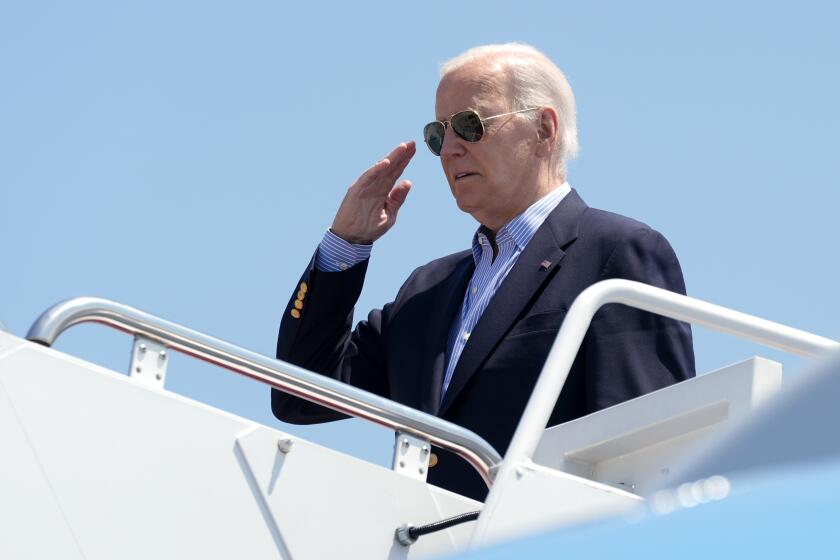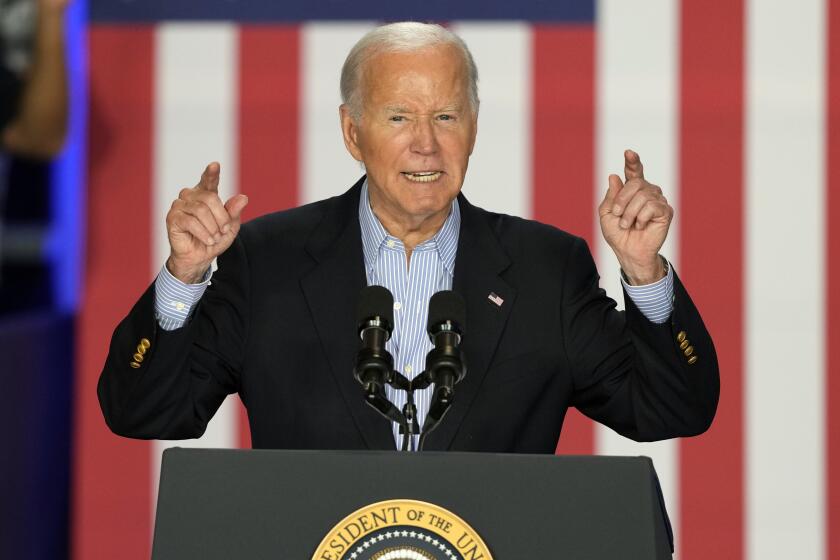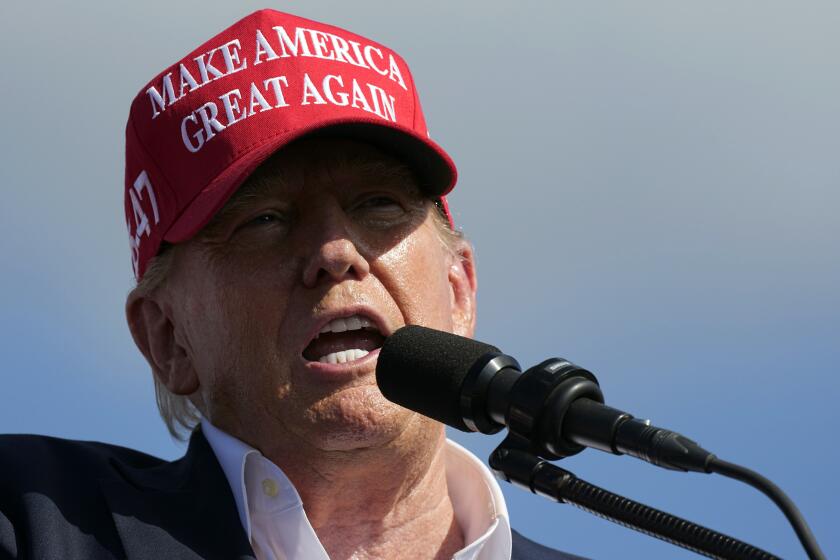Essential Politics: Are we watching ‘West Wing’ or ‘Veep’ in Biden’s Washington?

Last week, White House Press Secretary Jen Psaki joked that Washington felt like a television show. Asked which one, she said sometimes it was “The West Wing,” a gauzy portrayal of liberal pluck and earnestness, and other times it was “Veep,” an acerbic comedy about political selfishness and incompetence.
President Biden seems determined to prove that Washington is really more like the “West Wing,” a place where the old ways of doing business can still get the job done. He even took a page from that show’s fictional president, Josiah Bartlet, by visiting Capitol Hill to push his agenda. (However, Biden didn’t dramatically walk part of the way to the building after stopping to talk to some tourists from Kansas.)
But will any of this work? The only thing at stake is, well, Biden’s entire domestic agenda. The whole thing — road repairs, clean energy policies, child care, paid family leave and more — is rolled into two massive pieces of legislation that have been tied together, for better or worse.
It’s enough drama for more than one season of television, and there’s no guarantee of a happy ending for the president.
Get our L.A. Times Politics newsletter
The latest news, analysis and insights from our politics team.
You may occasionally receive promotional content from the Los Angeles Times.
Biden hits the road
Most of the news coverage has been focused on twists and turns on Capitol Hill as Biden has tried to line up the Democratic support necessary to move the legislation forward. It’s a narrative heavy on procedural minutiae and eye-popping dollar figures — not what any of the proposals could accomplish.
So the president decided to change the channel on Tuesday, heading to a swing district in Michigan.
“I know there’s a lot of noise in Washington,” Biden said as he started his speech at a union training facility. “There always is. But it seems to me a little more than usual now.”
His humble goal, he said, was to “try to set some things straight, if I can.”
Much of Biden’s speech was familiar. He spoke about ensuring the United States keeps pace with emerging economies, about the competition between democracies and autocracies, about making the wealthy pay their fair share of taxes.
But he added a new twist near the beginning where he described opponents of his agenda as standing on the wrong side of history. It was something of a “you’re either with us or against us” moment.
“To support these investments is to create a rising America, an America that’s moving,” he said. “To oppose these investments is to be complicit in America’s decline.”
When Biden’s motorcade arrived at the training facility, supporters and protesters were lined up outside. It’s clear he caught a glimpse of some of the signs — which said things like “say no to sleepy Joe” or “stop insane government spending” — because he defended his margin of victory in last year’s election during his speech.
“Eighty-one million Americans voted for me, the largest number of votes in American history,” he said, describing it as nothing short of a “clear majority.”
Our daily news podcast
If you’re a fan of this newsletter, you’ll probably love our new daily podcast, “The Times,” hosted by columnist Gustavo Arellano, along with reporters from across our newsroom. Every weekday, it takes you beyond the headlines. Subscribe on Apple Podcasts and follow on Spotify.
The “noise in Washington”
To recap, Biden’s agenda is split into two pieces of legislation. The first includes roughly $1 trillion for infrastructure, including repairing roads and replacing lead water pipes, and it passed with bipartisan support in the Senate. Now it’s waiting for a vote in the House, but progressive Democrats are withholding their support until they can reach a deal on the second, an even larger piece of legislation that includes social safety net programs.
This is generally described as the reconciliation package because it would need to be passed through the reconciliation process, allowing it to sidestep a Senate filibuster from Republicans.
Accomplishing that will require an unanimous Democratic caucus in the Senate, and right now Sens. Joe Manchin III of West Virginia and Kyrsten Sinema of Arizona are refusing to support the safety net legislation.
It’s unclear how large the final package will be. The legislation was originally pegged at $3.5 trillion, but that’s guaranteed to drop. Jennifer Haberkorn and Nolan D. McCaskill, who recently joined The Times as a congressional reporter after several years at Politico, analyzed how Democrats are trying to trim down their long list of proposals to reach a deal.
Biden has continued to press forward, confident that his proposals still have broad backing among the American people.
A new poll released by Quinnipiac University on Tuesday provides some evidence for that. Support for the infrastructure legislation has slipped only slightly, to 62% from 65% in August. And the reconciliation package has 57% support, down from 62%.
Enjoying this newsletter? Consider subscribing to the Los Angeles Times
Your support helps us deliver the news that matters most. Become a subscriber.
The latest from D.C.
It’s been several months since the Jan. 6 riot at the Capitol, and we’re still learning new things about how that day unfolded. Sarah D. Wire, who writes about Congress for The Times, recently uncovered another piece of the puzzle.
Her reporting started when she spoke with a staff member who was startled that supporters of former President Trump had been able to easily break the building’s windows — wasn’t the glass supposed to be bombproof? Eventually Sarah found out that about a dozen windows on the ground floor were never upgraded, leading to weak points that the rioters exploited.
It appears likely that reinforced glass will be installed as the building undergoes security improvements once again, but an engineering study must first be done to see whether the frames can hold the blastproof glass. “The windows that were broken on Jan. 6 are obviously a key area of focus,” Senate Sergeant at Arms Karen Gibson said in a statement.
We’ve also been covering how Biden has changed course — or not — after taking over from Trump, whom he not-so-affectionately calls “the former guy.”
One topic on which Biden appears to be staying the course is trade with China. Another colleague at The Times, Don Lee, reported on how Biden has kept tariffs in place and is prepared to aggressively enforce international agreements.
U.S. Trade Representative Katherine Tai, in her first major speech on the issue, said Monday that “China’s plans do not include meaningful reforms,” a sign that Biden doesn’t plan to reduce the pressure even as he tries to move away from Trump’s more chaotic approach.
California’s oil spill
Our team of journalists have been working around the clock to cover the oil spill off the coast of Orange County. On Monday, they revealed authorities had evidence that a leak had occurred 10 hours before the platform’s operator reported it. Aerial photos have captured the impact of 126,000 gallons of oil on the coastline.
The White House is keeping tabs on the spill. Psaki said “we are very engaged in the effort that is 24/7 at this point in time.”
Previous spills have been catalysts for the environmental movement. One of them occurred off the coast of Santa Barbara in 1969, releasing 3 million gallons of crude oil after Union Oil, now known as Unocal, was allowed to skirt safety measures.
As a result, lawmakers passed legislation in Sacramento and Washington that created new regulatory standards and more protections for sensitive habitats.
It remains to be seen whether the latest spill will have a similar effect.
At the beginning of Biden’s term, he paused the sale of new offshore drilling leases. However, a federal judge in Louisiana blocked the president’s order, and auctions have continued. Now there’s ongoing litigation as the Department of Interior tries to carry out Biden’s vision.
We asked Psaki about that push during Monday’s news briefing.
“Look, I think the president has identified addressing the climate crisis is a core priority for him and this administration. And certainly, taking every step possible to do that remains a priority,” she said. “I wouldn’t say that this changes that. That has been the case before this and will be the case even as we work to ensure recovery is complete.”
Stay in touch
Keep up with breaking news on our Politics page. And are you following us on Twitter at @latimespolitics?
Did someone forward you this? Sign up here to get Essential Politics in your inbox.
Until next time, send your comments, suggestions and news tips to politics@latimes.com.
Get the L.A. Times Politics newsletter
Deeply reported insights into legislation, politics and policy from Sacramento, Washington and beyond. In your inbox three times per week.
You may occasionally receive promotional content from the Los Angeles Times.




